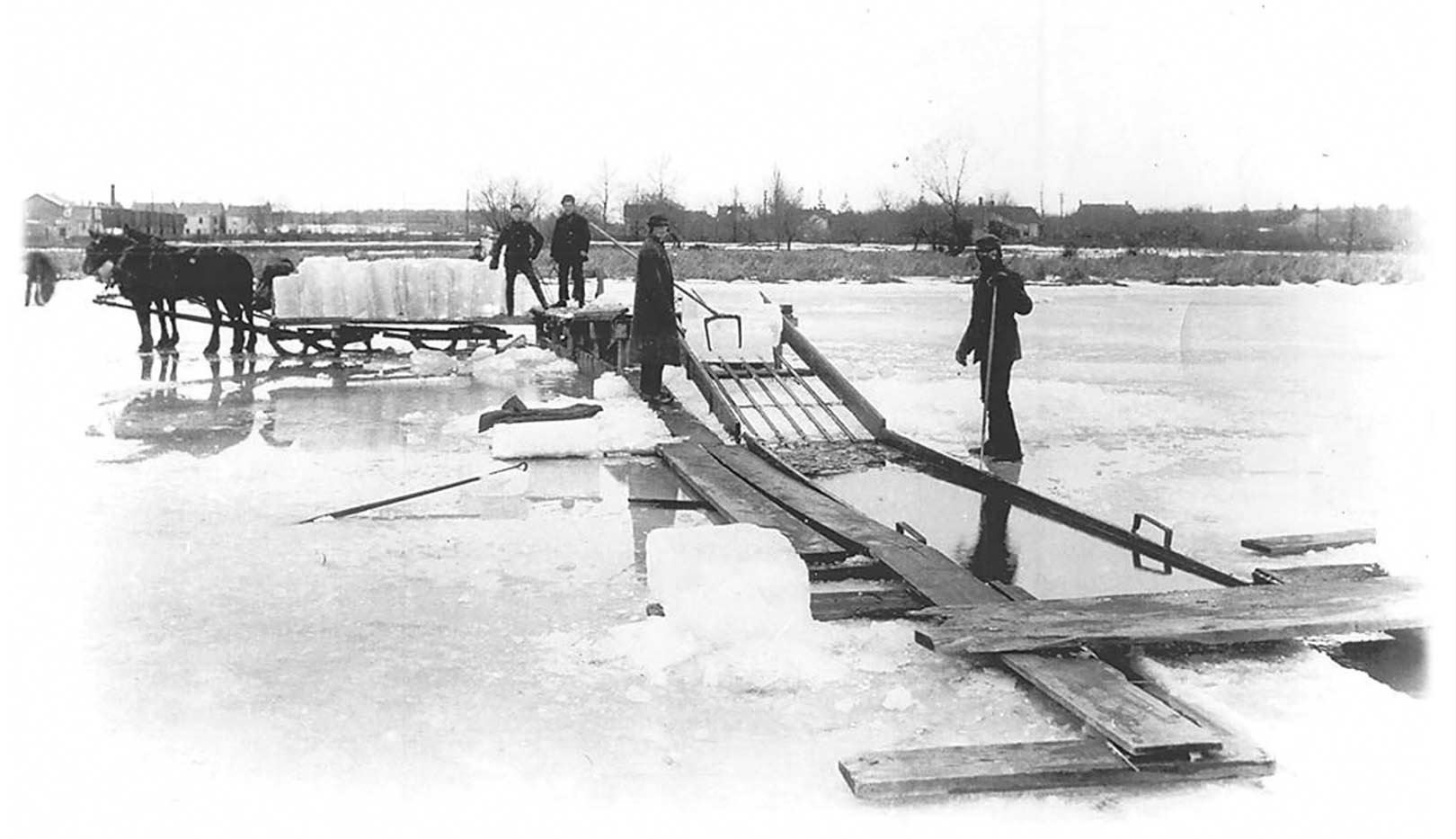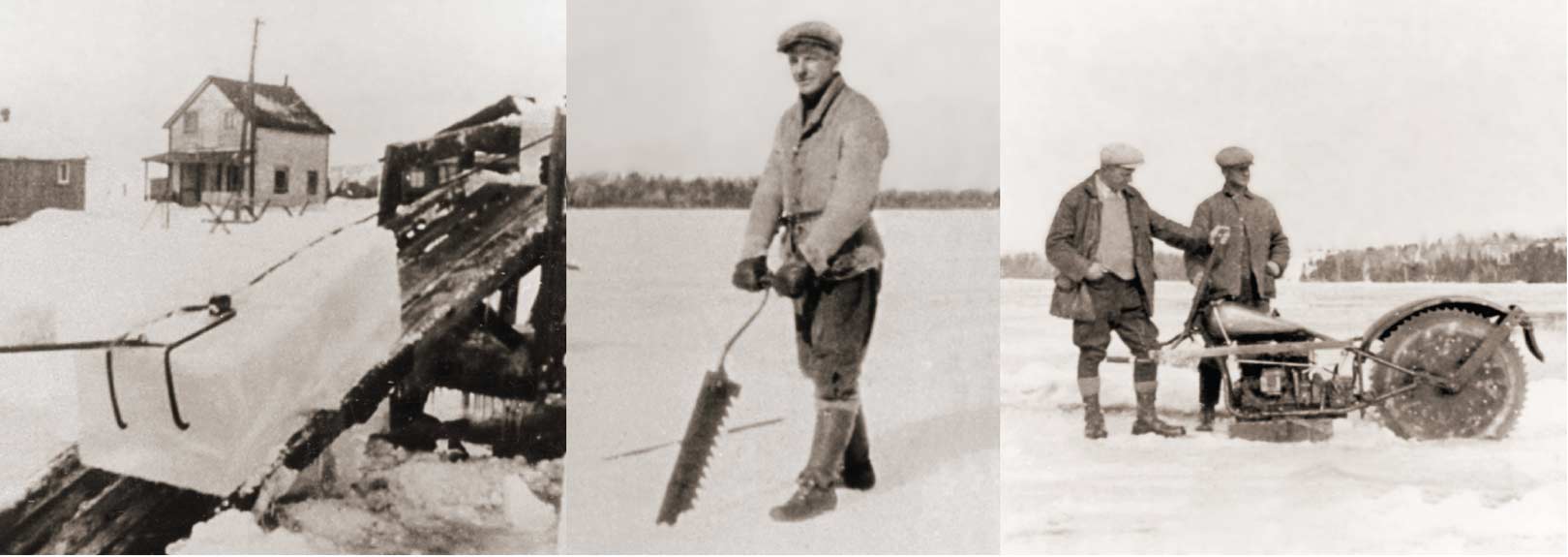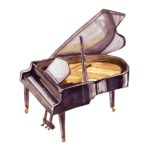

Left to right: Ice blocks being hauled up on shore in Presqu'ile Bay; typical hand ice saw; George Ventress from Presqu'ile working an ice saw converted from his motorcycle
The records gathered by ice harvesters over the past century are helping scientists complete the picture of the ecosystems supported by our frozen lakes.
The term “cold harvest” may elicit visions of icy grapes carefully picked from frosty vines, but in fact, the crop harvested in this case was ice. Ice harvesting became a local industry in the 1870s and continued to thrive across most of Ontario right up until the 1950s. Before the advent of electricity and modern refrigeration, packing things in ice was the only way to keep things cold; it was so vital it was referred to as a “winter crop.” In addition to keeping food and dairy products cool, ice was used in the meat-packing business and in the brewing industry, to regulate the fermentation temperature.
Harvesting ice in winter provided an income to those who worked on farms in the summer. But it was a brutal job. Days were long, with workers often beginning at 4 a.m. and working until sunset. Dangerous conditions and low pay came with the job.
As the harvesters knew all too well, the most dangerous part of the job was the risk of falling into the water, especially in years when the ice would take longer in the season to freeze to the required thickness. Local “ice roads” like the path across the Bay of Quinte, from Big Island to Point Anne, which was essential in transporting goods across to Belleville, were always risky, especially in warmer weather. In addition to the dangers of falling through the ice, the ice blocks would become too slushy to transport and pack – forcing local companies to ship ice from northern locations by rail to meet demand.
CUTTING THE ICE
An ice harvester would often have heavy iron tools to work with such as an ice plow, ice saw, grapples, and a series of pry bars of different sizes, for separating the cakes of ice. Most important was the long hand saw, used to manually cut the huge cakes of ice.
To harvest the ice, a team of men would wait until the lake or river ice was 15 to 20 inches thick, usually in mid-winter, and then clear the snow off the surface, measure and score the ice, and use the saws to cut it into blocks. More established harvesters would use a horse-drawn “cutter” that would plow back and forth over the surface ice to cut the ice “cakes” into bigger and more even cuts.
Manley L. Rusho confirms of his father’s harvesting operation near Kingston: “The horse walked in a straight line and made the cut into the ice – maybe two inches then four inches deep – with an attachment that was hooked to the saw. The attachment was dropped into the slot in the ice and within minutes the field was cut into blocks of ice…” George Ventress, an inventive Presqu’ile farmer came up with an easier method of cutting ice grids. He converted his 1930 Henderson motorcycle into a saw which worked much more efficiently than the handsaw or the horse drawn plough.
Whatever the cutting method, the ice was then extracted using huge tongs, hoisted onto sleighs and brought to shore, where the massive blocks (up to 300 pounds) would then be hauled onto another wagon bound for the icehouse.
Icehouses were equipped with good drainage and insulated with thick layers of sawdust and hay. During ice harvest in Presqu’ile Bay, one man and his team would deliver sawdust, which he picked up for free from the local mill, to the icehouse for $5 a day. The sheer volume of the tightly packed blocks also ensured that the ice stayed frozen.
THE ICEMAN COMES
The delivery process was another labour-intensive race against time. “Sleeping ice,” or the large packed blocks stored in the icehouse, were slid down runways to waiting wagons, and then the protective layer of sawdust was washed off. This massive block of ice would travel door to door and only be chiselled into smaller and more manageable blocks when it arrived at its delivery destination. Using special tongs, the delivery person would either carefully slide the block into an insulated cold room via a trapdoor on the outside of the house, or carry it directly into an icebox in the kitchen before it melted in the summer sun.
The ICE TODAY signs and the familiar ice delivery truck that replaced the horse-drawn wagon were still in operation until the early 1950s, when refrigerators became more economical and replaced the icebox. The “ice age,” when teams of horses and men hauled huge frozen blocks from our local lakes, came to an end with advent of modern refrigeration. However, researchers recognize the importance of the benchmarks recorded by this traditional industry and how they can help us understand future climate change.
ICE DATE – A BROADER SPECTRUM
Anecdotal accounts and company records dating back to the late 1800s, housed in local archives, are considered important early indicators of rising temperature trends in the Great Lakes. Climate forecasters at the Canadian Ice Service and the Faculty of Science at York University, in particular, are using that information to plot ice cover trends and to predict lake ice levels – all essential information for those who rely on the winter season to make their living.
Thanks in part to the ice harvesters, researchers have 100-plus years of ice coverage data and records from specific bays and specific locations.
The ice data, and in particular “ice timing,” have even greater implications for the local environment. Some of the same methods that the harvesters used to measure lake and river thickness are used by many operators in the tourism industry who offer winter activities like ice fishing and skating.
Ecologists have linked the freezing and thawing cycles of Lake Ontario to bird migration patterns at Presqu’ile Park, to algae bloom, at-risk fish populations in our local waterways, and even to the times when trees grow their foliage and specific plants produce fruit.
Thanks in part to the ice harvesters, researchers have 100-plus years of ice coverage data and records from specific bays and specific locations. Added to the data that scientists have collected, this has provided a broad spectrum of information that gives us a more complete picture of ice coverage. Lake Ontario can be seen as a barometer for the future.
People familiar with the region can see that the smaller lakes are warming faster and freezing a lot later in the season. They have less ice cover and are thawing earlier in the spring. This pattern of ice formation has occurred more in the past 25 years than in any previously recorded period. In the last 10 to 15 years, lakes to the north of us that have frozen every single year for the past 100 years have had multiple ice-free times.
This may seem like old news to those weary of hearing about climate change, but with this historical data that helps link ice degradation to warming climate trends, municipalities can better prepare for flooding and ice jams and predict power usage requirements. And lawmakers can be better informed and inspired to enact more effective policies to protect our environment.
So ice harvesters are back out on our lakes and rivers, but this time they are researchers extracting ice to take the temperature of our ecosystem. Just like the ice harvesters of old, however, they are still extracting ice in the hopes of keeping us cool in the summer.
Story by:
Micol Marotti




